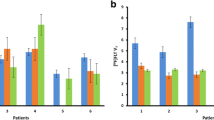Abstract
Although thallium-201 (201Tl) uptake is related to perfusion in many normal tissues, the biologic rationale for201Tl uptake in tumors is uncertain. To determine if tumor uptake is related to cell proliferation, we correlated the relative retention of201Tl in lung tumors with expression of Ki-67, an indicator of cell proliferation.Methods: Sixty patients with lung tumors, included small cell carcinoma (n=8) and non-small cell carcinoma (n=52), underwent201Tl single photon emission computed tomography (SPECT) imaging. The201Tl lesion uptake was determined on early and delayed images and the radiotracer retention index (RI) was calculated. Tumor specimens were obtained at surgery or bronchoscopy. The cell proliferation ratio was estimated with MIB-1, a monoclonal antibody that recognized the nuclear antigen Ki-67.Results: The average201Tl index was 2.13±0.61 (early) and 2.46±0.83 (delayed). The average RI was 17.44±35.01. Overall, the201Tl index (delayed) and the cancer cell proliferation were correlated (r=0.70, p<0.0001). Of interest, there was a significant correlation (r=0.872, p<0.0005) between the201Tl index on delayed images and the cell proliferation ratio in patients with small cell but not non-small cell lung carcinoma. The201Tl index (delayed) was significantly higher (p<0.0001) in patients with small cell lung carcinoma than in patients with non-small cell lung carcinoma.Conclusion:201Tl imaging appears to be useful for evaluating patients with small cell lung carcinoma but not non-small lung carcinoma, and is correlated with the monoclonal antibody MIB-1, a marker of cell proliferation.
Similar content being viewed by others
References
Cox PH, Belfer AJ, Pompe WB. Thallium-201 chloride uptake in tumors, a possible complication in heart scintigraphy.Br J Radiol 16: 425–430, 1976.
Salvatore M, Carratu L, Porta E. Thallium-201 as a positive indicator for lung neoplasm: preliminary experiments.Radiology 121: 487–488, 1976.
Tonami N, Hisada K. Clinical experience of tumor imaging with Tl-201 chloride.Clin Nucl Med 2: 75–81, 1977.
Tonami N, Shuke N, Yokoyama K, et al. Tl-201 single photon emission computed tomography in the evaluation of syspected lung cancer.J Nucl Med 30: 997–1004, 1989.
Takekawa H, Itoh K, Abe S, et al. Retention index of thallium-201 single photon emission computerized tomography (SPECT) as an indicator of metastasis in adenocarcinoma of the lung.Br J Cancer 70: 315–318, 1994.
Brismar T, Anderson S, Collins VP. Mechanism of high K+ and Tl+ uptake in cultured human glioma cells.Cell Mol Neurobiol 15: 351–360, 1995.
Brismar T, Gruber A, Peterson C. Increased cation transport inmdr1-gene-expressing K562 cells.Cancer Chemother Pharmacol 36: 87–90, 1995.
Ballinger JR, Sheldon KM, Boxen I, Erlichman C, Ling V. Differences between accumulation of99mTc-MIBI and201Tl-thallous chloride in tumour cells: role of P-glycoprotein.Q J Nucl Med 39: 122–128, 1995.
Brismar T, Collins VP, Kesselberg M. Thallium-201 uptake relates to membrane potential and potassium permeability in human glioma cells.Brain Research 500: 30–36, 1989.
Sessler MJ, Geck P, Maul FD, Hor G, Munz DL. New aspects of cellular thallium uptake: Tl+-Na+-2Cl(−)-cotransport is the central mechanism of ion uptake.Nuklearmedizin 25: 24–27, 1986.
Cattoretti G, Becker MHG, Key G, Firby P, Hartman NG, Moore MJ. Monoclonal antibodies against recombinant parts of the Ki-67 antigen (MIB1 and MIB3) detect proliferating cells in microwave-processed formalin-fixed paraffin sections.J Pathol 168: 357–363, 1992.
Youssef EM, Matsuda T, Takada N, et al. Prognostic significance of the MIB-1 proliferation index for patients with squamous cell carcinoma of the esophagus.Cancer 76: 358–366, 1995.
Lee CS. Difference in cell proliferation and prognostic significance of proliferating cell nuclear antigen and Ki-67 antigen immunoreactivityin situ and invasive carcinoma of the extrahepatic biliary tract.Cancer 78: 1881–1887, 1996.
Ishibashi M, Taguchi A, Sugita Y, et al. Thallium-201 in brain tumors: the relationship between the tumor cell activity in astrocytic tumor and proliferating cell nuclear antigen (PCNA).J Nucl Med 36: 2201–2206, 1995.
American Thoracic Society. Medical section of the American Lung Association: clinical staging of primary lung cancer.Am Rev Respir Dis 127: 659–664, 1983.
Beahrs OH. Manual for staging of cancer, 4th ed. American Joint Committee on Cancer (AJCC), Philadelphia, JB Lippincott, pp. 115–122, 1992.
Takekawa H, Itoh K, Abe S, et al. Thallium-201 uptake, histological difference and Na−K ATPase in lung adenocarcinoma.J Nucl Med 37: 955–958, 1996.
Price P, Bush C, Parkinson CS, Imrie P, Ormerod MG, Steel CG. Ki-67 in the assessment of tumor growth rate: a study on xenografts.Int J Radiat Biol 56: 787–800, 1989.
Nielssen AL, Nyholm HC, Engel P. Expression of MIB-1 (paraffin Ki-67) and AgNCR morphology in endometrial adenocarcinomas of endometrioid type.Int J Gynecol Pathol 13: 37–44, 1994.
Simony J, Pujol JL, Radal M, Ursule E, Michel FB, Pujol H.In situ evaluation of growth fraction determined by monoclonal antibody Ki-67 and ploidy in surgically resected non-small cell lung cancers.Cancer Res 50: 4382–4387, 1990.
Lopez P, Belloe F, Lacombe F, et al. Modalities of synthesis of Ki-67 antigen during the stimulation of lymphocytes.Cytometry 12: 42–49, 1991.
Buruno S, Darzynkiewiez Z. Cell cycle dependent expression and stability of the nuclear protein detected by Ki-67 antibody in SHL-60 cells.Cell Prolif 25: 31–40, 1992.
Tungekar MF, Gatter KC, Dunnil MS, Mason DY. Ki-67 immunostaining and survival in operable lung cancer.Histopathology 19: 545–550, 1991.
Author information
Authors and Affiliations
Corresponding author
Rights and permissions
About this article
Cite this article
Ishibashi, M., Fujii, T., Yamana, H. et al. Relationship between cancer cell proliferation and thallium-201 uptake in lung cancer. Ann Nucl Med 14, 255–261 (2000). https://doi.org/10.1007/BF02988207
Received:
Accepted:
Issue Date:
DOI: https://doi.org/10.1007/BF02988207




